Complexity of the human memory B-cell compartment is determined by the versatility of clonal diversification in germinal centers
- PMID: 26324941
- PMCID: PMC4586852
- DOI: 10.1073/pnas.1511270112
Complexity of the human memory B-cell compartment is determined by the versatility of clonal diversification in germinal centers
Abstract
Our knowledge about the clonal composition and intraclonal diversity of the human memory B-cell compartment and the relationship between memory B-cell subsets is still limited, although these are central issues for our understanding of adaptive immunity. We performed a deep sequencing analysis of rearranged immunoglobulin (Ig) heavy chain genes from biological replicates, covering more than 100,000 memory B lymphocytes from two healthy adults. We reveal a highly similar B-cell receptor repertoire among the four main human IgM(+) and IgG(+) memory B-cell subsets. Strikingly, in both donors, 45% of sequences could be assigned to expanded clones, demonstrating that the human memory B-cell compartment is characterized by many, often very large, B-cell clones. Twenty percent of the clones consisted of class switched and IgM(+)(IgD(+)) members, a feature that correlated significantly with clone size. Hence, we provide strong evidence that the vast majority of Ig mutated B cells--including IgM(+)IgD(+)CD27(+) B cells--are post-germinal center (GC) memory B cells. Clone members showed high intraclonal sequence diversity and high intraclonal versatility in Ig class and IgG subclass composition, with particular patterns of memory B-cell clone generation in GC reactions. In conclusion, GC produce amazingly large, complex, and diverse memory B-cell clones, equipping the human immune system with a versatile and highly diverse compartment of IgM(+)(IgD(+)) and class-switched memory B cells.
Keywords: IgM memory; IgV gene repertoire; clonal composition; human memory B cell subsets.
Conflict of interest statement
The authors declare no conflict of interest.
Figures
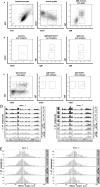



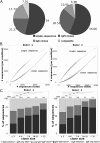
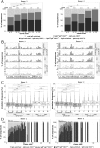

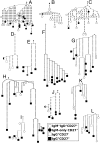
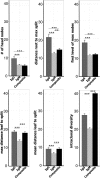

Similar articles
-
Molecular footprints of a germinal center derivation of human IgM+(IgD+)CD27+ B cells and the dynamics of memory B cell generation.J Exp Med. 2009 Nov 23;206(12):2659-69. doi: 10.1084/jem.20091087. Epub 2009 Nov 16. J Exp Med. 2009. PMID: 19917772 Free PMC article.
-
Molecular analysis of IgD-positive human germinal centres.Int Immunol. 2010 Apr;22(4):289-98. doi: 10.1093/intimm/dxq007. Epub 2010 Feb 5. Int Immunol. 2010. PMID: 20139173
-
Human immunoglobulin (Ig)M+IgD+ peripheral blood B cells expressing the CD27 cell surface antigen carry somatically mutated variable region genes: CD27 as a general marker for somatically mutated (memory) B cells.J Exp Med. 1998 Nov 2;188(9):1679-89. doi: 10.1084/jem.188.9.1679. J Exp Med. 1998. PMID: 9802980 Free PMC article.
-
Human memory B cells.Leukemia. 2016 Dec;30(12):2283-2292. doi: 10.1038/leu.2016.226. Epub 2016 Aug 8. Leukemia. 2016. PMID: 27499139 Review.
-
Human IgM-expressing memory B cells.Front Immunol. 2023 Dec 8;14:1308378. doi: 10.3389/fimmu.2023.1308378. eCollection 2023. Front Immunol. 2023. PMID: 38143767 Free PMC article. Review.
Cited by
-
Memory B cell heterogeneity: Remembrance of things past.J Leukoc Biol. 2018 Feb;103(2):269-274. doi: 10.1002/JLB.4MR0517-215R. Epub 2018 Jan 17. J Leukoc Biol. 2018. PMID: 29345369 Free PMC article. Review.
-
IgM+IgD- B cells in human gut-associated lymphoid tissue have memory features and give rise to IgM+ and IgA+ antibody-secreting cells.Sci Rep. 2025 Jul 22;15(1):26613. doi: 10.1038/s41598-025-11209-1. Sci Rep. 2025. PMID: 40695977 Free PMC article.
-
Novel Allele Detection Tool Benchmark and Application With Antibody Repertoire Sequencing Dataset.Front Immunol. 2021 Oct 26;12:739179. doi: 10.3389/fimmu.2021.739179. eCollection 2021. Front Immunol. 2021. PMID: 34764956 Free PMC article.
-
CD27 on human memory B cells-more than just a surface marker.Clin Exp Immunol. 2023 Jul 21;213(2):164-172. doi: 10.1093/cei/uxac114. Clin Exp Immunol. 2023. PMID: 36508329 Free PMC article. Review.
-
Human IgMhiCD300a+ B Cells Are Circulating Marginal Zone Memory B Cells That Respond to Pneumococcal Polysaccharides and Their Frequency Is Decreased in People Living with HIV.Int J Mol Sci. 2023 Sep 6;24(18):13754. doi: 10.3390/ijms241813754. Int J Mol Sci. 2023. PMID: 37762055 Free PMC article.
References
-
- Alt FW, Blackwell TK, Yancopoulos GD. Development of the primary antibody repertoire. Science. 1987;238(4830):1079–1087. - PubMed
-
- MacLennan IC. Germinal centers. Annu Rev Immunol. 1994;12:117–139. - PubMed
-
- Manis JP, Tian M, Alt FW. Mechanism and control of class-switch recombination. Trends Immunol. 2002;23(1):31–39. - PubMed
Publication types
MeSH terms
Substances
Associated data
LinkOut - more resources
Full Text Sources
Other Literature Sources
Research Materials
Miscellaneous

